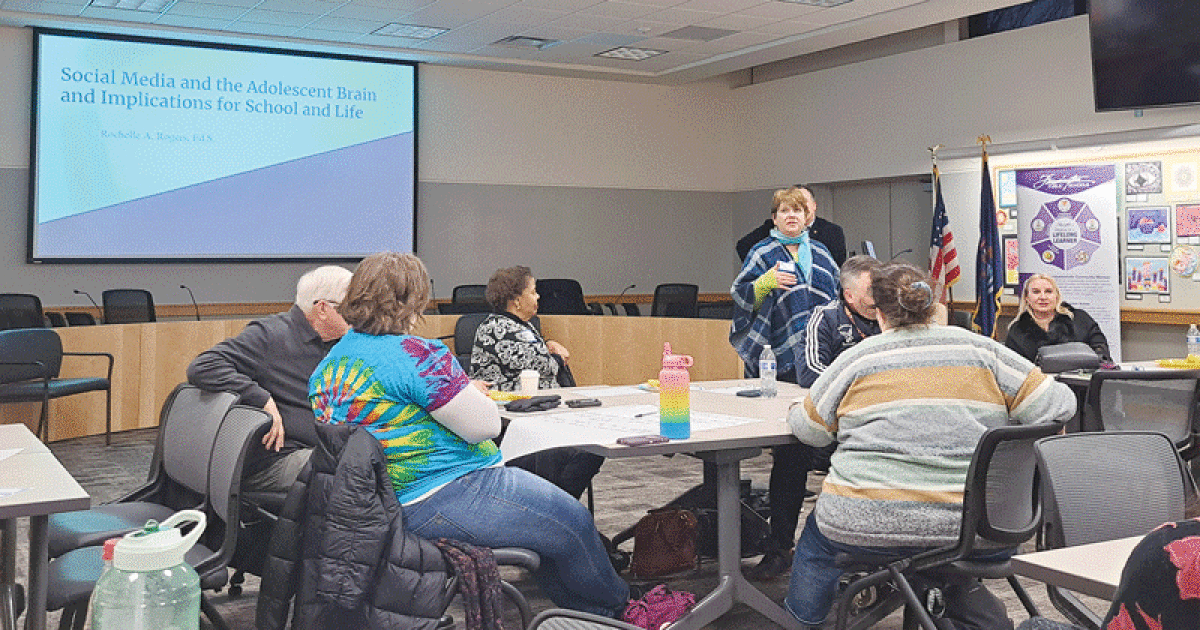FARMINGTON — The Farmington Public Schools Board of Education held a community dialogue March 15 on the positive and negative effects of students using social media at the Maxfield Education Center, 32789 W. 10 Mile Road in Farmington.
This was the second quarterly discussion the board’s Community Engagement Committee has held in an effort to gather the community’s feedback and perceptions on topics that are pertinent to student life.
“The goal is for you to speak with your board of education about an important topic, and what could be more important than the mental health and well-being of our children? And so that’s the topic for tonight,” said Superintendent Christopher Delgado.
The event featured a 20-minute presentation by Rochelle A. Rogers, the social studies department chair and an AP psychology teacher at Seaholm High School in Birmingham, on the negative effects social media has on all people, but especially young people. According to Rogers, research on social media has grown exponentially over the last seven years that she has been teaching it.
“It’s important for both students and parents to know the implications of social media,” said Rogers.
She said she purposefully starts the semester with a unit on social media because her AP psychology class is mostly seniors who will be going on spring break. She said that a lot of damage can be caused by simply making or liking a post. She cited how several students had had their admissions to Harvard repealed as a result of their social media posts, as well as how a pediatric anesthesiologist had been fired over liking a controversial post.
“I want them to be very careful what they’re posting, because certain things happen, and they’re going to go to college, and there are going to be huge ramifications if things go out,” Rogers said. “Whatever you’re doing or (wherever you’re) going, you want to be very mindful about what you’re putting out, because once that picture of you in a bikini or something goes out, you can’t take it back.”
Rogers said that social media is addictive in nature. She said it brings forth the same dopamine rush as a drug. She said that when it seems people are addicted to their cellphones, it is because they are. Rogers said she conducted a survey of her students the week before final exams and found that the average student spent 27 hours a week on social media.
“Social media platforms drive surges of dopamine to the brain to keep consumers coming back over and over again,” said Rogers. “The shares, the likes, the content — that helps trigger the brain’s reward center, resulting in a high similar to what people feel when gambling or using drugs. So, whether it’s your child, student or yourself, you want to know how many people liked your Instagram post, what do people think about their Twitter, and it’s a constant feed. These are adolescents, and they’re looking for their identity. How’s it going? How am I doing? Is what I’m presenting — do people like it? Am I getting the acceptance that I wanted? It’s true for all of us. But one of the things that you see in kids is that they’re compulsive about it in a lot of ways. As teachers and as educators and as parents, you’re saying, ‘Put your phone away,’ and it’s like they think that you are literally the devil when you want to take the phone away. … So, it is a powerful reaction in the brain similar to that of a drug.”
She said that kids and teens are particularly susceptible to the addictiveness of social media because their brains are rapidly developing. Rogers said that social media can actually rewire a child’s brain to constantly seek out immediate gratification. She said social media can be associated with anxiety, depression, attention deficit hyperactivity disorder, body dysmorphia and worse.
However, she said research has shown that children who are able to delay gratification have higher achievement.
“That’s what’s so important for students, is to have that ability to put your phone away and delay that gratification — delay that fix. If you will, you are going to be more successful and a higher achiever,” said Rogers.
She said that students spend an average of five to six hours per day on social media, which is nearly the equivalent of a full-time job, and that they are often tired and run down. She approaches the subject with her students by asking how many of them could use more sleep and how many of them feel there are not enough hours in the day to get everything done, and then asks if they have time for a full-time job. She then presents the idea of “Super Time.” During “Super Time,” kids are asked to put their phone in a special spot and focus on the tasks they need to complete. She said that her students are often amazed at how much they can accomplish when they “Super Time.”
“Students don’t realize how much time they are actually spending (on social media), and they often feel overwhelmed, anxious and are exhausted. .... This is about their mental health, and they don’t recognize it. I have to suggest, whether you are a parent or an educator, you can’t say they can’t do this. You have to let them realize how this is affecting them,” said Rogers. “I’m very clear that this needs to be presented in a non-punitive way. They have to be the ones to realize, right? If we tell them ‘No. Don’t do it.’ Then it is a punishment, but if they realize, they can be in charge of it.”
Following Rogers’ presentation, participants were given a copy of an article by Sherri Gordon titled “Surprising ways your teen benefits from social media,” and they were asked to ponder the information from both sides. According to Gordon’s article, social media can benefit students by strengthening friendships, motivating kids to do good, reducing feelings of isolation, becoming a source of support, building a platform, encouraging personal expression and providing access to information.
Many Farmington High School teachers participated in the discussion and offered their insight on the use of phones/social media in the classroom.
First-year teacher Anthony Pattah said that he does not allow cellphone use in his class room, and he has a strict policy that students are given a letter home every time they are caught using the phone during class time. After three letters, the student will receive a markdown on his/her participation points.
Pattah said he found out recently that the number of students he had asking to use the bathroom dropped dramatically when he mandated that they leave their cellphone on their desk. He said it went from an average of 10 students needing to use the restroom during class to two.
His colleague, Mellissa Chapman, said that she has different policies for different classes. She said her AP class, which consists of seniors who will soon be on their way out the door to college and beyond, is allowed to have them. However, in her sophomore classes, she will collect the phones in a bin while she lectures and then give them back at the end of the lesson.
“It’s about how it’s used and the fact that guides are needed,” said Don Walker, Farmington Public Schools Board of Education member and CEC head.
“We’re moving into a digital world whether we like it or not. They have to know how we use it wisely, and our job as parents and teachers is to guide them. ... We don’t have to be a jerk about it. We just say when it is appropriate and when it is not appropriate,” said Farmington High School teacher Tim Russel. “We have to train them on something we never knew about. The idea is that we now have to go backward and look at what it is doing to them, and they now have to go forward into a digital world. So, you can’t demonize it all. You have to model appropriate usage.”
Chapman agreed and added that adults have to educate on what can go wrong as well. She said they should tell students: If you do this, here are the things that could happen, and here are the very serious ramifications.
Board member Angie Smith said that in one sense she doesn’t want phones in schools, but if you look at what happened at the Oxford and Michigan State University school shootings, phones do matter. She said she wants them to be there as a means of communication.
Rogers pointed out that sometimes, while students appear to be not listening, often they are researching the topic at hand on the internet when they are on their phones during a lecture. She said that is part of how society operates today.
“I think that we’re never going to all come to a consensus or find the perfect answer, but I am so impressed with the way the conversation is flowing,” Rogers said at the end of the session.
The next session will be held at 6:30 p.m. May 30 at the Maxfield Education Center. The topic is yet to be determined.
 Publication select ▼
Publication select ▼























